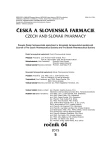HPLC method for stability evaluation of pharmaceutical preparations containing sodium picosulfate
Authors:
Petr Kastner; Kateřina Burdová; Pavla Pilařová
Authors place of work:
Faculty of Pharmacy in Hradec Králové, Charles University, Department of Pharmaceutical Chemistry and Drug Control, Hradec Králové, Czech Republic
Published in the journal:
Čes. slov. Farm., 2015; 64, 215
Category:
44<sup>th</sup> Conference drug synthesis and analysis
Introduction
Nowadays, HPLC is the most widely spread and powerful analytical tool in drug control. It is the first choice method for the solution of all problems connected with the evaluation of related substances and the assay of the active substance as well as the preservative. This separation method was thus used to develop an analytical method which enables evaluation of oral liquid drug preparations containing sodium picosulfate as the favoured laxative drug.
Experimental method
HPLC separation of components was achieved with LiChroCART®, 250 ×⋅ 4.0, Purospher® STAR, RP – 18 C, 5 μμm column using a UV detector at 263 nm. The mobile phase consisted of a buffer, acetonitrile and isopropylalcohol in the ratio of 55 : 43 : 2 (v/v/v). The buffer contained disodium hydrogen phosphate, water R and cetyltrimethylammonium bromide. The pH value was adjusted by phosphoric acid to 7.0. The temperature of the column was 40 °C, injection volume 4 μμμl, the flow rate was adjusted to 1.0 ml/min.

Results and discussion
The developed method was based on a valid pharmacopoeial one1), it was optimized for and then it was validated2) as sufficiently selective, precise, accurate, linear and sensitive. Robustness was tested by means of the Plackett-Burman design3) and it was found that the ratio of acetonitrile in the mobile phase exerts the greatest influence on separation from all proved parameters. On the other hand, flow, buffer concentration and the ratio of propan-2-ol in the mobile phase little affect the separation.
Conclusions
The developed method enables simultaneous evaluation of the content of the active ingredient, its related substances and the preservative. It was sufficiently validated from the standpoint of selectivity, linearity, precision, accuracy, sensitivity and robustness, and can be used for release control of the pharmaceutical preparation and for its stability studies, too.
This work was supported by a research project SVV 260062.
Conflicts of interest: none.
PharmDr. Petr Kastner, Ph.D.
Faculty of Pharmacy
Heyrovského 1203, 500 05 Hradec Králové, Czech Republic
e-mail: kastner@faf.cuni.cz
Zdroje
1. European Pharmacopoeia. 8th ed. Strasbourg: Council Of Europe, 2013.
2. ICH [online] 2013 [cit. 2013-12-11]. Available from: http://www.ich.org/products/guidelines/quality/qualitysingle/article/ validation-of-analytical-procedures-text-and-methodology.html
3. Holík M. Optimalizace analytických postupů pomocí Plackettova-Burmanova plánu. Chemické listy. Praha: Česká společnost chemická 2004; 98.
Štítky
Farmacie FarmakologieČlánek vyšel v časopise
Česká a slovenská farmacie

2015 Číslo 5
- Přerušovaný půst může mít významná zdravotní rizika
- Ukažte mi, jak kašlete, a já vám řeknu, co vám je
- Mikroplasty a jejich riziko pro zdraví: Co všechno víme?
Nejčtenější v tomto čísle
- Metody používané ve farmaceutické technologii ke zvyšování biologické dostupnosti špatně rozpustných léčiv po perorálním podání
- Formulační aspekty orodispergovatelných tablet
- Prof. RNDr. Jaroslav Květina, DrSc. dr.h.c. FCMA – 85letý
- Hodnocení sypných a konsolidačních vlastností prášků ve farmaceutické technologii
